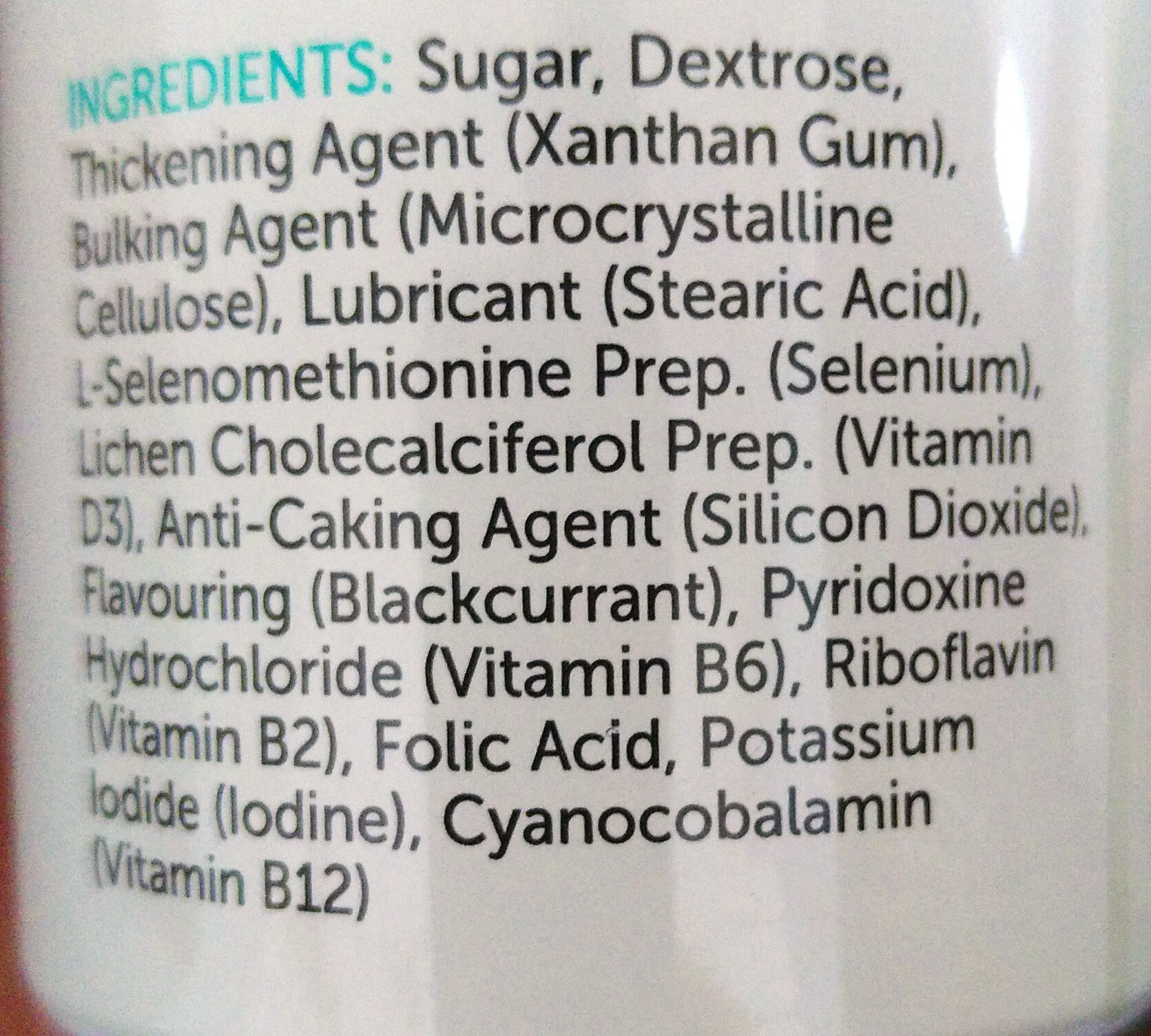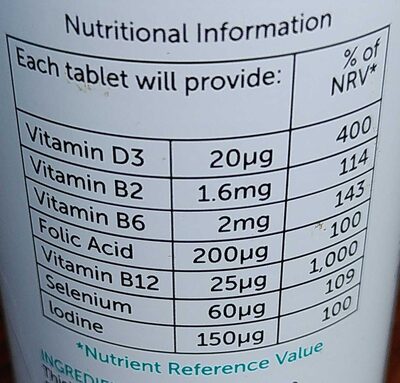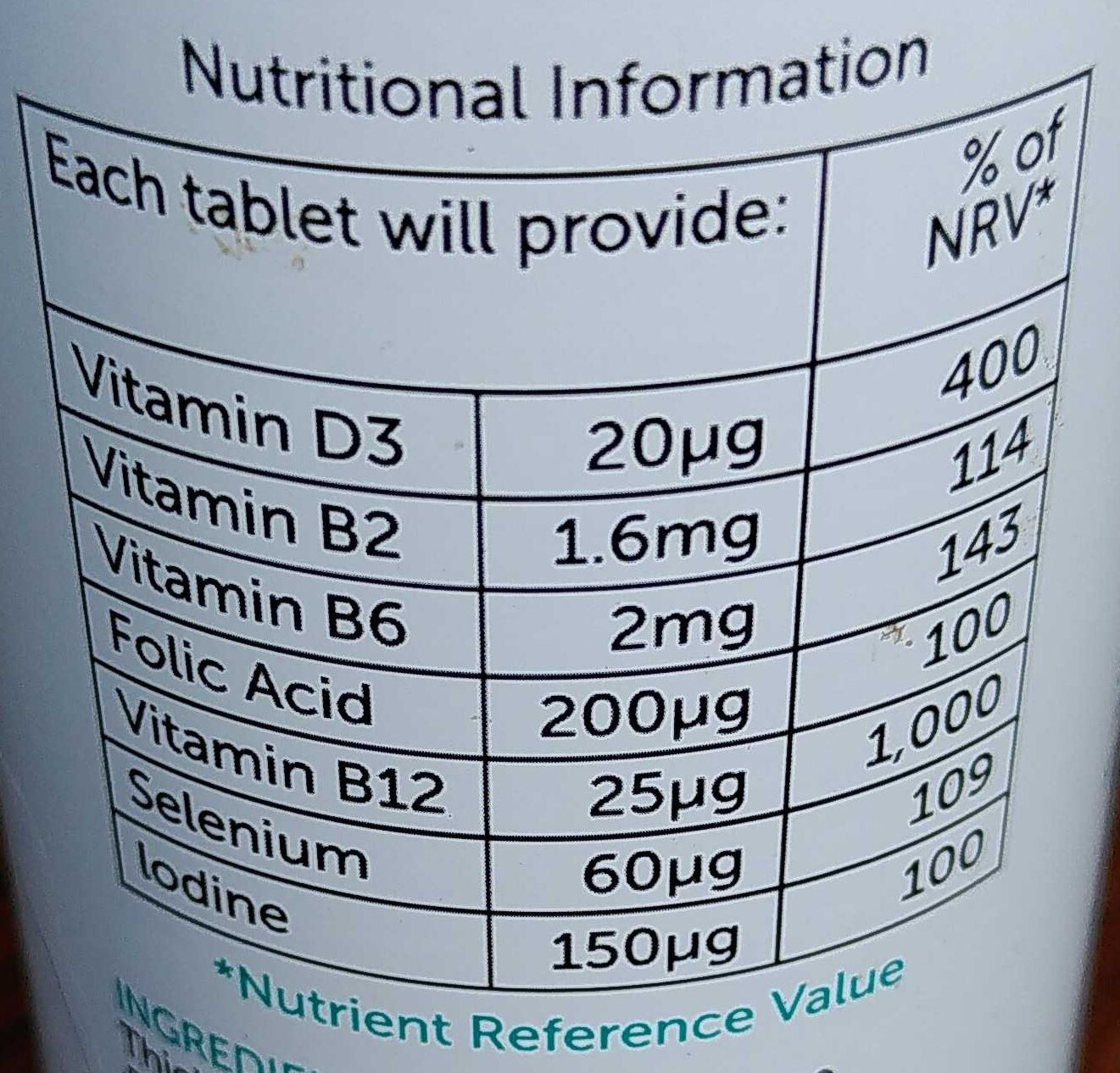Help us make food transparency the norm!
As a non-profit organization, we depend on your donations to continue informing consumers around the world about what they eat.
The food revolution starts with you!
Veg1 - The vegan society - 151g
Veg1 - The vegan society - 151g
This product page is not complete. You can help to complete it by editing it and adding more data from the photos we have, or by taking more photos using the app for Android or iPhone/iPad. Thank you!
×
Barcode: 5065000944070 (EAN / EAN-13)
Common name: Vitamin Tablets
Quantity: 151g
Packaging: Metal, Recyclable Metals, Aluminium
Brands: The vegan society
Categories: Dietary supplements, Vitamins
Labels, certifications, awards:
No gluten, Vegetarian, Vegan, No lactose, No wheat, The Vegan Society, Yeast-free
Manufacturing or processing places: United Kingdom
Countries where sold: France, United Kingdom
Matching with your preferences
Health
Ingredients
-
25 ingredients
Sugar, Dextrose, Thickening Agent (Xanthan Gum), Bulking Agent (Microcrystalline Cellulose), Lubricant (Stearic Acid), L-Selenomethionine Prep. (Selenium), Lichen Cholecalciferol Prep. (Vitamin D3), Anti-Caking Agent (Silicon Dioxide). Flavouring (Blackcurrant), Pyridoxine Hydrochloride (Vitamin B6), Riboflavin (Vitamin B2), Folic Acid, Potassium lodide (lodine), Cyanocobalamin (Vitamin B12)
Food processing
-
Ultra processed foods
Elements that indicate the product is in the 4 - Ultra processed food and drink products group:
- Additive: E415 - Xanthan gum
- Additive: E460 - Cellulose
- Additive: E551 - Silicon dioxide
- Ingredient: Bulking agent
- Ingredient: Dextrose
- Ingredient: Flavouring
- Ingredient: Glucose
- Ingredient: Thickener
Food products are classified into 4 groups according to their degree of processing:
- Unprocessed or minimally processed foods
- Processed culinary ingredients
- Processed foods
- Ultra processed foods
The determination of the group is based on the category of the product and on the ingredients it contains.
Additives
-
E415 - Xanthan gum
Xanthan gum (E415) is a natural polysaccharide derived from fermented sugars, often used in the food industry as a thickening and stabilizing agent.
This versatile food additive enhances texture and prevents ingredient separation in a wide range of products, including salad dressings, sauces, and gluten-free baked goods.
It is considered safe for consumption even at high intake amounts.
-
E460 - Cellulose
Cellulose: Cellulose is an organic compound with the formula -C6H10O5-n, a polysaccharide consisting of a linear chain of several hundred to many thousands of β-1→4- linked D-glucose units. Cellulose is an important structural component of the primary cell wall of green plants, many forms of algae and the oomycetes. Some species of bacteria secrete it to form biofilms. Cellulose is the most abundant organic polymer on Earth. The cellulose content of cotton fiber is 90%, that of wood is 40–50%, and that of dried hemp is approximately 57%.Cellulose is mainly used to produce paperboard and paper. Smaller quantities are converted into a wide variety of derivative products such as cellophane and rayon. Conversion of cellulose from energy crops into biofuels such as cellulosic ethanol is under development as a renewable fuel source. Cellulose for industrial use is mainly obtained from wood pulp and cotton.Some animals, particularly ruminants and termites, can digest cellulose with the help of symbiotic micro-organisms that live in their guts, such as Trichonympha. In human nutrition, cellulose is a non-digestible constituent of insoluble dietary fiber, acting as a hydrophilic bulking agent for feces and potentially aiding in defecation.Source: Wikipedia
-
E460i - Microcrystalline cellulose
Cellulose: Cellulose is an organic compound with the formula -C6H10O5-n, a polysaccharide consisting of a linear chain of several hundred to many thousands of β-1→4- linked D-glucose units. Cellulose is an important structural component of the primary cell wall of green plants, many forms of algae and the oomycetes. Some species of bacteria secrete it to form biofilms. Cellulose is the most abundant organic polymer on Earth. The cellulose content of cotton fiber is 90%, that of wood is 40–50%, and that of dried hemp is approximately 57%.Cellulose is mainly used to produce paperboard and paper. Smaller quantities are converted into a wide variety of derivative products such as cellophane and rayon. Conversion of cellulose from energy crops into biofuels such as cellulosic ethanol is under development as a renewable fuel source. Cellulose for industrial use is mainly obtained from wood pulp and cotton.Some animals, particularly ruminants and termites, can digest cellulose with the help of symbiotic micro-organisms that live in their guts, such as Trichonympha. In human nutrition, cellulose is a non-digestible constituent of insoluble dietary fiber, acting as a hydrophilic bulking agent for feces and potentially aiding in defecation.Source: Wikipedia
-
E551 - Silicon dioxide
Silicon dioxide: Silicon dioxide, also known as silica, silicic acid or silicic acid anydride is an oxide of silicon with the chemical formula SiO2, most commonly found in nature as quartz and in various living organisms. In many parts of the world, silica is the major constituent of sand. Silica is one of the most complex and most abundant families of materials, existing as a compound of several minerals and as synthetic product. Notable examples include fused quartz, fumed silica, silica gel, and aerogels. It is used in structural materials, microelectronics -as an electrical insulator-, and as components in the food and pharmaceutical industries. Inhaling finely divided crystalline silica is toxic and can lead to severe inflammation of the lung tissue, silicosis, bronchitis, lung cancer, and systemic autoimmune diseases, such as lupus and rheumatoid arthritis. Uptake of amorphous silicon dioxide, in high doses, leads to non-permanent short-term inflammation, where all effects heal.Source: Wikipedia
-
E570 - Fatty acids
Fatty acid: In chemistry, particularly in biochemistry, a fatty acid is a carboxylic acid with a long aliphatic chain, which is either saturated or unsaturated. Most naturally occurring fatty acids have an unbranched chain of an even number of carbon atoms, from 4 to 28. Fatty acids are usually not found per se in organisms, but instead as three main classes of esters: triglycerides, phospholipids, and cholesterol esters. In any of these forms, fatty acids are both important dietary sources of fuel for animals and they are important structural components for cells.Source: Wikipedia
Ingredients analysis
-
Palm oil content unknown
Unrecognized ingredients: Lubricant, L-selenomethionine-prep, Lichen-cholecalciferol-prep, Potassium-lodide, LodineSome ingredients could not be recognized.
We need your help!
You can help us recognize more ingredients and better analyze the list of ingredients for this product and others:
- Edit this product page to correct spelling mistakes in the ingredients list, and/or to remove ingredients in other languages and sentences that are not related to the ingredients.
- Add new entries, synonyms or translations to our multilingual lists of ingredients, ingredient processing methods, and labels.
If you would like to help, join the #ingredients channel on our Slack discussion space and/or learn about ingredients analysis on our wiki. Thank you!
-
Vegan
No non-vegan ingredients
Unrecognized ingredients: Lubricant, L-selenomethionine-prep, Selenium, Lichen-cholecalciferol-prep, Folic acid, Potassium-lodide, Lodine, Cyanocobalamin, Vitamin b12Some ingredients could not be recognized.
We need your help!
You can help us recognize more ingredients and better analyze the list of ingredients for this product and others:
- Edit this product page to correct spelling mistakes in the ingredients list, and/or to remove ingredients in other languages and sentences that are not related to the ingredients.
- Add new entries, synonyms or translations to our multilingual lists of ingredients, ingredient processing methods, and labels.
If you would like to help, join the #ingredients channel on our Slack discussion space and/or learn about ingredients analysis on our wiki. Thank you!
-
Vegetarian
No non-vegetarian ingredients detected
Unrecognized ingredients: Lubricant, L-selenomethionine-prep, Selenium, Lichen-cholecalciferol-prep, Folic acid, Potassium-lodide, Lodine, Cyanocobalamin, Vitamin b12Some ingredients could not be recognized.
We need your help!
You can help us recognize more ingredients and better analyze the list of ingredients for this product and others:
- Edit this product page to correct spelling mistakes in the ingredients list, and/or to remove ingredients in other languages and sentences that are not related to the ingredients.
- Add new entries, synonyms or translations to our multilingual lists of ingredients, ingredient processing methods, and labels.
If you would like to help, join the #ingredients channel on our Slack discussion space and/or learn about ingredients analysis on our wiki. Thank you!
-
Details of the analysis of the ingredients
We need your help!
Some ingredients could not be recognized.
We need your help!
You can help us recognize more ingredients and better analyze the list of ingredients for this product and others:
- Edit this product page to correct spelling mistakes in the ingredients list, and/or to remove ingredients in other languages and sentences that are not related to the ingredients.
- Add new entries, synonyms or translations to our multilingual lists of ingredients, ingredient processing methods, and labels.
If you would like to help, join the #ingredients channel on our Slack discussion space and/or learn about ingredients analysis on our wiki. Thank you!
: Sugar, Dextrose, Thickening Agent (Xanthan Gum), Bulking Agent (Microcrystalline Cellulose), Lubricant (Stearic Acid), L-Selenomethionine Prep (Selenium), Lichen Cholecalciferol Prep (Vitamin D3), Anti-Caking Agent (Silicon Dioxide), Flavouring (Blackcurrant), Pyridoxine Hydrochloride (Vitamin B6), Riboflavin (Vitamin B2), Folic Acid, Potassium lodide (lodine), Cyanocobalamin (Vitamin B12)- Sugar -> en:sugar - vegan: yes - vegetarian: yes - ciqual_proxy_food_code: 31016 - percent_min: 7.14285714285714 - percent_max: 100
- Dextrose -> en:dextrose - vegan: yes - vegetarian: yes - ciqual_proxy_food_code: 31016 - percent_min: 0 - percent_max: 50
- Thickening Agent -> en:thickener - percent_min: 0 - percent_max: 33.3333333333333
- Xanthan Gum -> en:e415 - vegan: yes - vegetarian: yes - percent_min: 0 - percent_max: 33.3333333333333
- Bulking Agent -> en:bulking-agent - percent_min: 0 - percent_max: 25
- Microcrystalline Cellulose -> en:e460i - vegan: yes - vegetarian: yes - percent_min: 0 - percent_max: 25
- Lubricant -> en:lubricant - percent_min: 0 - percent_max: 20
- Stearic Acid -> en:e570 - vegan: maybe - vegetarian: maybe - percent_min: 0 - percent_max: 20
- L-Selenomethionine Prep -> en:l-selenomethionine-prep - percent_min: 0 - percent_max: 16.6666666666667
- Selenium -> en:selenium - percent_min: 0 - percent_max: 16.6666666666667
- Lichen Cholecalciferol Prep -> en:lichen-cholecalciferol-prep - percent_min: 0 - percent_max: 14.2857142857143
- Vitamin D3 -> en:cholecalciferol - vegan: maybe - vegetarian: maybe - percent_min: 0 - percent_max: 14.2857142857143
- Anti-Caking Agent -> en:anti-caking-agent - percent_min: 0 - percent_max: 12.5
- Silicon Dioxide -> en:e551 - vegan: yes - vegetarian: yes - percent_min: 0 - percent_max: 12.5
- Flavouring -> en:flavouring - vegan: maybe - vegetarian: maybe - percent_min: 0 - percent_max: 5
- Blackcurrant -> en:blackcurrant - vegan: yes - vegetarian: yes - ciqual_food_code: 13007 - percent_min: 0 - percent_max: 5
- Pyridoxine Hydrochloride -> en:pyridoxine-hydrochloride - vegan: yes - vegetarian: yes - percent_min: 0 - percent_max: 5
- Vitamin B6 -> en:vitamin-b6 - vegan: yes - vegetarian: yes - percent_min: 0 - percent_max: 5
- Riboflavin -> en:e101 - vegan: maybe - vegetarian: yes - percent_min: 0 - percent_max: 5
- Vitamin B2 -> en:e101 - vegan: maybe - vegetarian: yes - percent_min: 0 - percent_max: 5
- Folic Acid -> en:folic-acid - percent_min: 0 - percent_max: 5
- Potassium lodide -> en:potassium-lodide - percent_min: 0 - percent_max: 5
- lodine -> en:lodine - percent_min: 0 - percent_max: 5
- Cyanocobalamin -> en:cyanocobalamin - percent_min: 0 - percent_max: 5
- Vitamin B12 -> en:vitamin-b12 - percent_min: 0 - percent_max: 5
Nutrition
-
Good nutritional quality
⚠ ️Warning: the amount of fiber is not specified, their possible positive contribution to the grade could not be taken into account.⚠ ️Warning: the amount of fruits, vegetables and nuts is not specified on the label, it was estimated from the list of ingredients: 0This product is not considered a beverage for the calculation of the Nutri-Score.
Positive points: 0
- Proteins: 0 / 5 (value: 0, rounded value: 0)
- Fiber: 0 / 5 (value: 0, rounded value: 0)
- Fruits, vegetables, nuts, and colza/walnut/olive oils: 0 / 5 (value: 0.181361607142861, rounded value: 0.2)
Negative points: 0
- Energy: 0 / 10 (value: 0, rounded value: 0)
- Sugars: 0 / 10 (value: 0, rounded value: 0)
- Saturated fat: 0 / 10 (value: 0, rounded value: 0)
- Sodium: 0 / 10 (value: 0, rounded value: 0)
The points for proteins are counted because the negative points are less than 11.
Nutritional score: (0 - 0)
Nutri-Score:
-
Nutrient levels
-
Fat in low quantity (0%)
What you need to know- A high consumption of fat, especially saturated fats, can raise cholesterol, which increases the risk of heart diseases.
Recommendation: Limit the consumption of fat and saturated fat- Choose products with lower fat and saturated fat content.
-
Saturated fat in low quantity (0%)
What you need to know- A high consumption of fat, especially saturated fats, can raise cholesterol, which increases the risk of heart diseases.
Recommendation: Limit the consumption of fat and saturated fat- Choose products with lower fat and saturated fat content.
-
Sugars in low quantity (0%)
What you need to know- A high consumption of sugar can cause weight gain and tooth decay. It also augments the risk of type 2 diabetes and cardio-vascular diseases.
Recommendation: Limit the consumption of sugar and sugary drinks- Sugary drinks (such as sodas, fruit beverages, and fruit juices and nectars) should be limited as much as possible (no more than 1 glass a day).
- Choose products with lower sugar content and reduce the consumption of products with added sugars.
-
Salt in low quantity (0%)
What you need to know- A high consumption of salt (or sodium) can cause raised blood pressure, which can increase the risk of heart disease and stroke.
- Many people who have high blood pressure do not know it, as there are often no symptoms.
- Most people consume too much salt (on average 9 to 12 grams per day), around twice the recommended maximum level of intake.
Recommendation: Limit the consumption of salt and salted food- Reduce the quantity of salt used when cooking, and don't salt again at the table.
- Limit the consumption of salty snacks and choose products with lower salt content.
-
-
Nutrition facts
Nutrition facts As sold
for 100 g / 100 mlAs sold
per serving (1g)Compared to: Vitamins Energy 0 kj
(0 kcal)0 kj
(0 kcal)-100% Fat 0 g 0 g -100% Saturated fat 0 g 0 g -100% Carbohydrates 0 g 0 g -100% Sugars 0 g 0 g -100% Fiber ? ? Proteins 0 g 0 g -100% Salt 0 g 0 g -100% Vitamin D 20 µg 0.2 µg -96% Vitamin B2 (Riboflavin) 0 mg 0 mg -100% Vitamin B6 (Pyridoxin) 0 mg 0 mg -100% Vitamin B9 (Folic acid) 200 µg 2 µg -98% Vitamin B12 (cobalamin) 25 µg 0.25 µg -46% Selenium 60 µg 0.6 µg -81% Iodine 150 µg 1.5 µg -86% Fruits‚ vegetables‚ nuts and rapeseed‚ walnut and olive oils (estimate from ingredients list analysis) 0.181 % 0.181 %
Environment
-
Eco-Score not computed - Unknown environmental impact
We could not compute the Eco-Score of this product as it is missing some data, could you help complete it?Could you add a precise product category so that we can compute the Eco-Score? Add a category
Packaging
-
Packaging with a high impact
-
Packaging parts
Bottle (Plastic)
Bottle cap (HDPE 2 - High-density polyethylene)
Pot (HDPE 2 - High-density polyethylene)
-
Packaging materials
Material % Packaging weight Packaging weight per 100 g of product Plastic
-
Transportation
-
Origins of ingredients
Missing origins of ingredients information
⚠ ️ The origins of the ingredients of this product are not indicated.
If they are indicated on the packaging, you can modify the product sheet and add them.
If you are the manufacturer of this product, you can send us the information with our free platform for producers.Add the origins of ingredients for this product Add the origins of ingredients for this product
Report a problem
-
Incomplete or incorrect information?
Category, labels, ingredients, allergens, nutritional information, photos etc.
If the information does not match the information on the packaging, please complete or correct it. Open Food Facts is a collaborative database, and every contribution is useful for all.
Data sources
Product added on by jm0804
Last edit of product page on by alexandre-copertino.
Product page also edited by babafofie, ecoscore-impact-estimator, makuikui, openfoodfacts-contributors, packbot, sebleouf, swipe-studio, vaporous, yuka.UUlZTlBZdFlvZUFOc2ZBUzJETFd4b2dwOXBPdlQyK3FjdlVUSVE9PQ.









